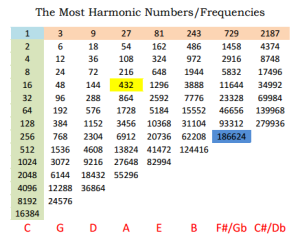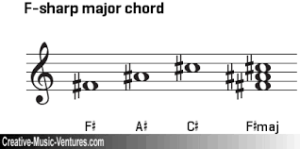I’ve been watching some NOVA and other scientific videos on quantum mechanics and physics. This has then led reading articles, blog posts, and comments about how there are so many coincidences in the world with certain numbers. But, for some, if there’s not an exact match, scientists chalk certain things up to chance.
The speed of light is a perfect example. From what I can find, the speed of light travels at 186,282 miles per second. The number for the speed of light just happens to be less than 1% different from an “F#” in the A=432 concert pitch. So, the number of the speed of light, translated to a frequency, shows that if we were to assign a pitch for the speed of light, that pitch would be less than 1% away from the frequency of an “F#” (186,624). I suppose you could translate that percentage point into Hertz, making it difficult to hear any “beating” between those two pitches because they are so close.
 In my last blog post, I reviewed a video where the narrator took numbers from geometric shapes and added up the interior angles to get a total. After doing this, he took those numbers and compared them to a chart of frequencies within the A=432 concert pitch (Pythagorean tuning). Those numbers also happen to be musical frequencies within an “F#” major chord (F#, A#, and C#). In this case, they are exact matches. See the table, from Stanford University, on what are considered the most harmonic numbers. Again, they are based on Pythagorean tuning (or ratios of 1:1, 2:1, etc.) This is where my geekiness kicks in… I actually recorded a full album based on the “F#” major chord! It’s called “Open Gates.” I had quite a bit of fun doing this album!
In my last blog post, I reviewed a video where the narrator took numbers from geometric shapes and added up the interior angles to get a total. After doing this, he took those numbers and compared them to a chart of frequencies within the A=432 concert pitch (Pythagorean tuning). Those numbers also happen to be musical frequencies within an “F#” major chord (F#, A#, and C#). In this case, they are exact matches. See the table, from Stanford University, on what are considered the most harmonic numbers. Again, they are based on Pythagorean tuning (or ratios of 1:1, 2:1, etc.) This is where my geekiness kicks in… I actually recorded a full album based on the “F#” major chord! It’s called “Open Gates.” I had quite a bit of fun doing this album!
There are a lot of people, both scientists and “number” enthusiasts who like to compare numbers between disciplines (measurements, distances, time, frequencies, etc.). It would seem that cross-referencing disciplines is nothing new…
Let’s look at our educational system for a moment. When we send our kids to school, we expect them to learn the basics (reading, writing, math, science, etc.). I remember when I started my public school teaching career in 1991, the buzz word at that time was “cooperative learning.” In a sense, it meant that we were to try and tie in all subject matter so students were cross-learning the information. As a music teacher, that was easy to do by incorporating history and culture into the music we did in class.
 Fast forward over 20 years and we once again are starting to see an emphasis on comparisons between subject matters. No, some of us are no longer in school, but, if you really want to call a spade a spade… we’re in school for life and should always be learning. With that, I don’t find it a stretch to see how numbers in math can also be a musical frequency. The key here is to look for patterns and consistencies. If the numbers you’re seeing don’t fit into some type of pattern, then they are probably not connected to anything else.
Fast forward over 20 years and we once again are starting to see an emphasis on comparisons between subject matters. No, some of us are no longer in school, but, if you really want to call a spade a spade… we’re in school for life and should always be learning. With that, I don’t find it a stretch to see how numbers in math can also be a musical frequency. The key here is to look for patterns and consistencies. If the numbers you’re seeing don’t fit into some type of pattern, then they are probably not connected to anything else.
Let’s take a look at the speed of light that I listed above. Remember, I said it’s an “F#” (out of hearing range). Then, compare that to the numbers from the added up angles of shapes, which happen to be the exact pitches used in an “F#” major chord. In music, there’s always more emphasis on the “tonic” or main note of a chord or scale. So, my guess is that we’re going to see more of “F#” than “A#” or “C#.” What’s even more interesting is that all of these numbers (translated to musical frequencies of the F# major triad) are ALL within the A=432 concert pitch. Coincidence? I’ll let you be the judge of that.
 In the usual teacher fashion, I have a little assignment for you! As you find numbers that appear to relate across several different disciplines, please share your findings here. I’ll then look up those numbers (or you can) to see if they have a musical frequency value. NOTE: you’ll need to do this using Pythagorean tuning.
In the usual teacher fashion, I have a little assignment for you! As you find numbers that appear to relate across several different disciplines, please share your findings here. I’ll then look up those numbers (or you can) to see if they have a musical frequency value. NOTE: you’ll need to do this using Pythagorean tuning.
I’m looking forward to what you have to share! I’m curious as to how many more “F#’s” are going to show up. Don’t you just love all those sharps! Ahhh… time to go practice my “F#” scales and arpeggios. I’ll join the Aristocats during their warmups.
Post your results below of any coincidences between numbers!
© 2015 by Del Hungerford
[mailerlite_form form_id=2]

